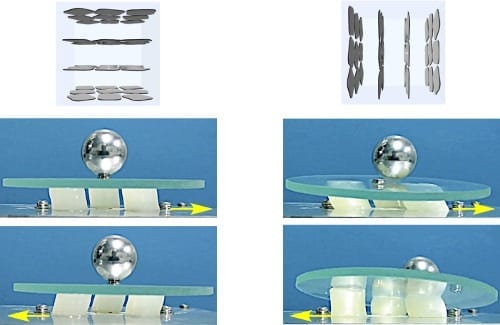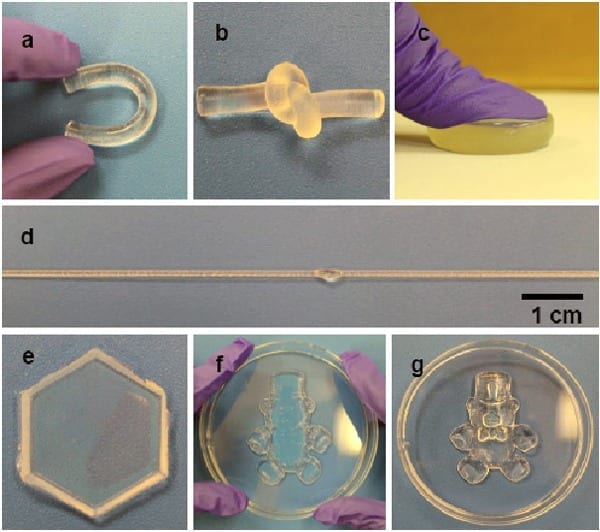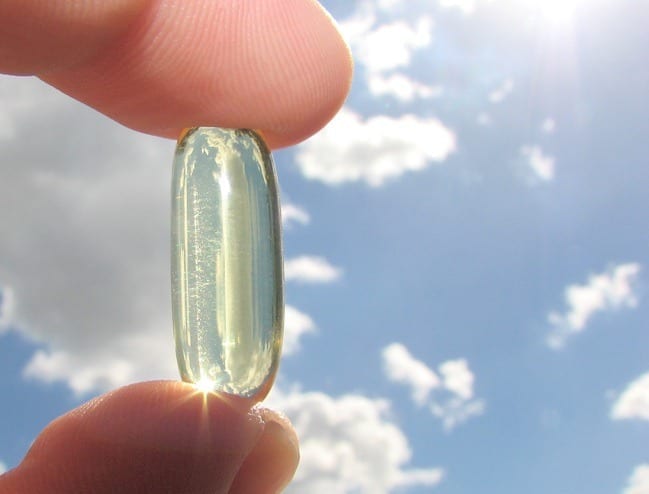
In a world-first achievement, scientists from the RIKEN Center for Emergent Matter Science in Japan, along with colleagues from the National Institute of Material Science and the University of Tokyo, have developed a new hydrogel whose properties are dominated by electrostatic repulsion, rather than attractive interactions.
According to Yasuhiro Ishida, head of the Emergent Bioinspired Soft Matter Research Team, the work began from a surreptitious discovery, that when titanate nano-sheets are suspended in an aqueous colloidal dispersion, they align themselves face-to-face in a plane when subjected to a strong magnetic field. The field maximizes the electrostatic repulsion between them and entices them into a quasi-crystalline structure. They naturally orient themselves face to face, separated by the electrostatic forces between them.
To create the new material, the researchers used the newly discovered method to arrange layers of the sheets in a plane, and once the sheets were aligned in the plane, fixed the magnetically induced structural order by transforming the dispersion into a hydrogel using a procedure called light-triggered in-situ vinyl polymerization. Essentially, pulses of light are used to congeal the aqueous solution into a hydrogel, so that the sheets could no longer move.
By doing this, they created a material whose properties are dominated by electrostatic repulsion, the same force that makes our hair stand end when we touch a van generator.
Up to now, manmade materials have not taken advantage of this phenomenon, but nature has. Cartilage owes its ability to allow virtually frictionless mechanical motion within joints, even under high compression, to the electrostatic forces inside it. Electrostatic repulsive forces are used in various places, such as maglev trains, vehicle suspensions and noncontact bearings, but up to now, materials design has focused overwhelmingly on attractive interactions.
Read more: A repulsive material
The Latest on: Repulsive hydrogel
[google_news title=”” keyword=”Repulsive hydrogel” num_posts=”10″ blurb_length=”0″ show_thumb=”left”]
via Google News
The Latest on: Repulsive hydrogel
- How Gary Oldman’s farting, belching and manic charisma made Slow Horses one of the best shows on TVon May 7, 2024 at 11:13 pm
The Apple TV+ series is up for the top prize at the Baftas, and it deserves one for Oldman’s sublimely repulsive performance alone, writes Nick Hilton ...
- Best Gel Mattress for 2024on May 1, 2024 at 3:31 pm
If you’re a hot sleeper and you’re looking for a new mattress with pressure relief and motion isolation, consider switching to a gel memory foam mattress. This is a popular choice in ...
- The Uglification of Everythingon April 25, 2024 at 3:52 pm
Wonder Land: Whether it’s members of Congress, protesters in the street, even golf tournaments—it’s hard not to notice the rising tide of jerk-like behavior. Images: Storyblocks/TikTok ...
- SEAN HANNITY: Schools do nothing in the face of 'raw, repulsive' antisemitismon April 23, 2024 at 8:05 pm
Fox News host Sean Hannity unpacks the anti-Israel protests disrupting college campuses in his opening monologue on "Hannity," specifically calling out these institutions' presidents. SEAN HANNITY ...
- This Is The Safest, Expert-Approved Way To Remove Gel Nail Enhancementson April 22, 2024 at 4:59 pm
However, if time is limited, you may find yourself searching through the bathroom cabinets to remove your gel enhancements at home. Below, Hackle explains the safest way to remove your gel nail ...
- Biden’s new Title IX revisions are a repulsive attempt to erase biological truthon April 22, 2024 at 4:58 pm
Last week, as the country was swept up in Caitlin Clark mania, Joe Biden — or whoever was holding his phone — sent out a pandering tweet, asking for compensation parity in women’s sports.
- Groundbreaking hydrogel can remove microplastics from wateron April 20, 2024 at 6:01 am
If you buy through a BGR link, we may earn an affiliate commission, helping support our expert product labs. A newly developed hydrogel can safely remove microplastics from water, a study reveals.
- 31 TV Characters That Were Repulsive Human Beings When You Really Think About Iton April 15, 2024 at 5:00 pm
At first glance, these characters might be sweet or hilariously funny, but they are repulsive in so many ways.
- New Hydrogel Material Removes Microplastics From Wateron April 14, 2024 at 5:00 pm
Researchers have developed a new multi-layered hydrogel material that can effectively capture microplastics from contaminated water and break them down when exposed to ultraviolet (UV) light. The new ...
- Best mould removers to keep your bathroom fungus-free, from sprays to scrubberson December 20, 2023 at 5:31 pm
Mould anywhere in the home is never an appealing prospect, but it feels extra repulsive in the bathroom ... this formula is essentially bleach in gel form, which means it won’t run off down into the ...
via Bing News











